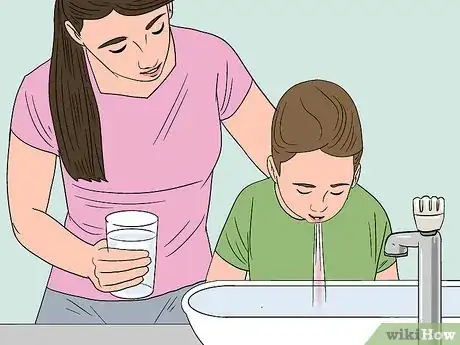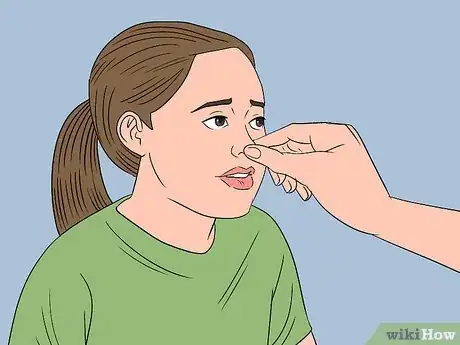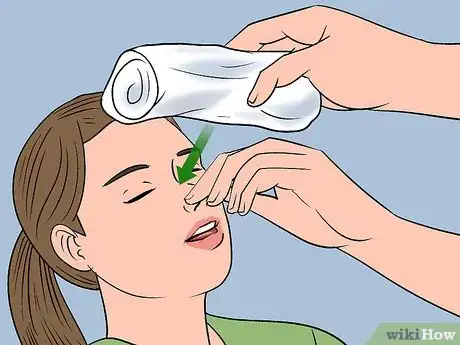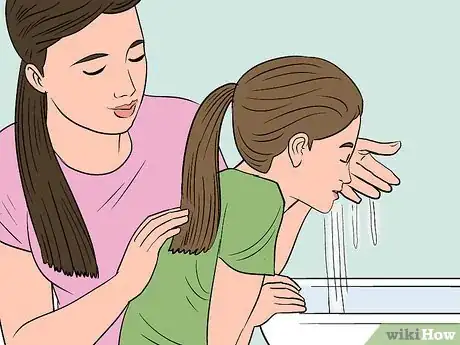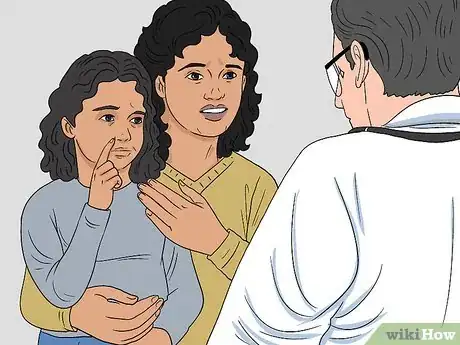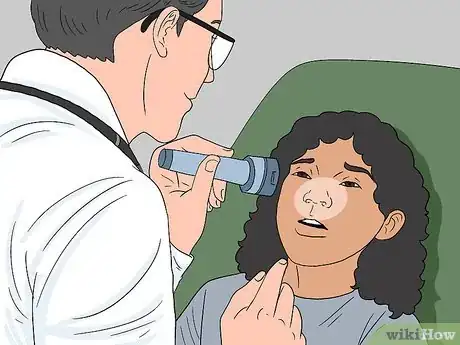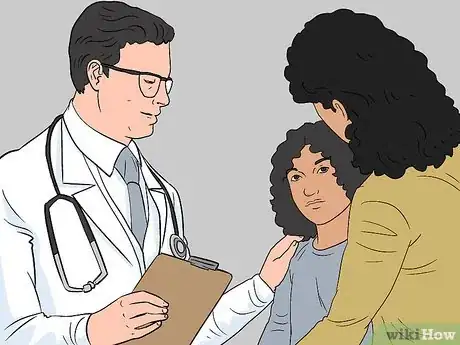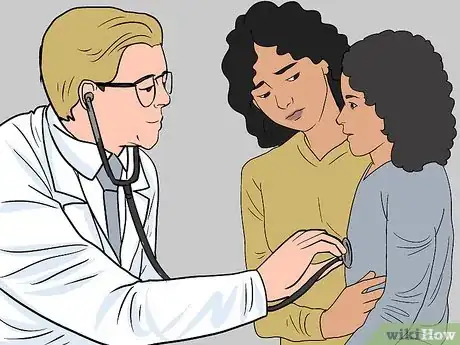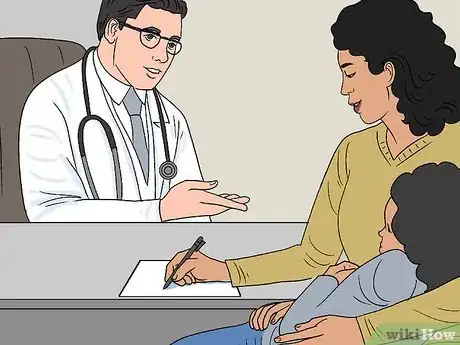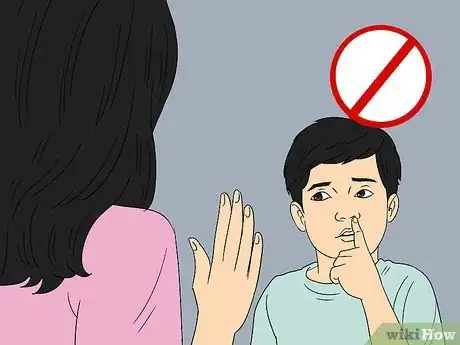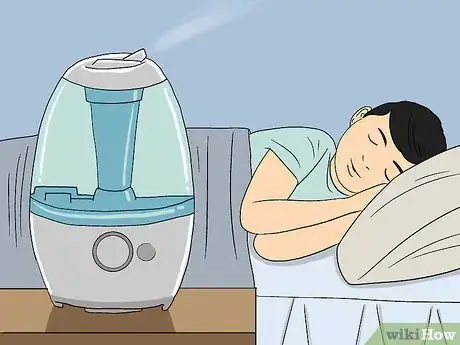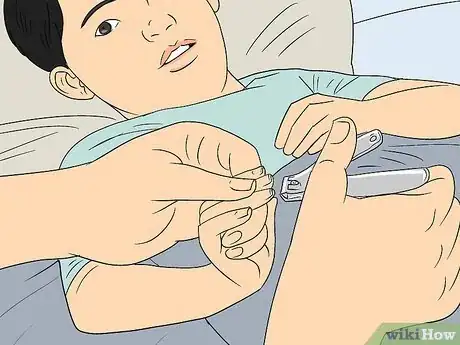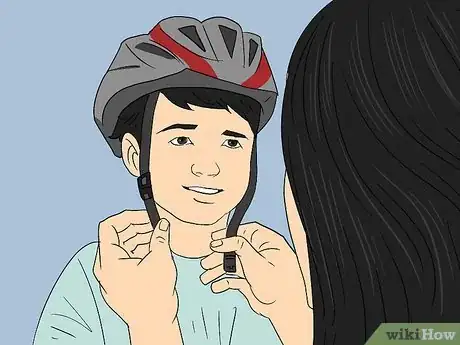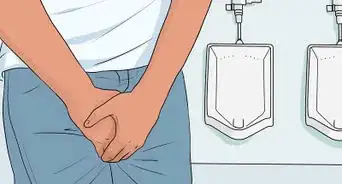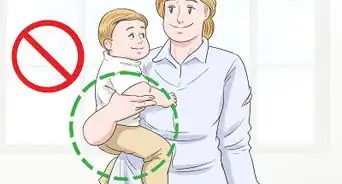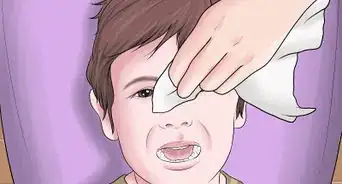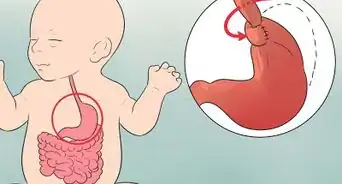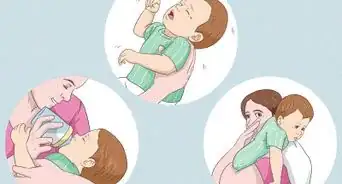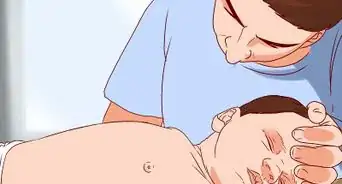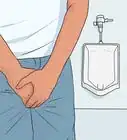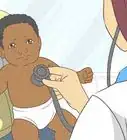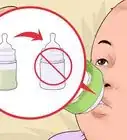This article was medically reviewed by Luba Lee, FNP-BC, MS and by wikiHow staff writer, Jennifer Mueller, JD. Luba Lee, FNP-BC is a Board-Certified Family Nurse Practitioner (FNP) and educator in Tennessee with over a decade of clinical experience. Luba has certifications in Pediatric Advanced Life Support (PALS), Emergency Medicine, Advanced Cardiac Life Support (ACLS), Team Building, and Critical Care Nursing. She received her Master of Science in Nursing (MSN) from the University of Tennessee in 2006.
This article has been viewed 11,658 times.
A nosebleed can be a frightening experience for a child, but usually, it's not any cause for alarm. If you remain calm, the child will likely calm down as well. Typically, you can stop a child's nosebleed on your own. However, if the child's nose is still bleeding after 20 minutes, contact their pediatrician. If a child has one nosebleed, they're likely to have another within the next few days. However, if nosebleeds continue to recur frequently, the child may have a more serious underlying medical condition that requires treatment.[1]
Steps
Caring for a Nosebleed at Home
-
1Calm and reassure the child. The sight of blood can be scary for children, and the child may be concerned that something is seriously wrong with them. Remain calm yourself and tell the child that they'll be okay.[2]
- If the child is crying, you might rub their back and encourage them to take deep breaths through their mouth and calm down. If the child continues to cry, it can make the nosebleed worse.
-
2Encourage the child to spit out any blood that has entered their mouth. If the child's nose has been bleeding for a minute or so, it's likely that some of the blood has dripped onto their lips or into their mouth. If the child swallows the blood, they could vomit.[3]
- You may need to get the child to swish some water around in their mouth before spitting so they can make sure they get it all out.
Advertisement -
3Sit the child in an upright position leaning slightly forward. Have the child sit on the edge of a sturdy chair so they can lean forward. For toddlers and smaller children, you might want to sit down yourself and hold the child in your lap so you can keep them still.[4]
- Make sure the child isn't leaning so far forward that their head is below the level of their heart. The child should still be in a predominantly upright position.
Warning: Don't allow the child to lie back in a reclining position — the blood could flow back into their throat and they could choke on it.
-
4Pinch the child's nostrils shut gently. Squeeze firmly but gently, with the tips of your fingers just above the edge of the child's nostrils. Tell the child to breathe through their mouth while you're doing this.[5]
- Hold the child's nose closed for 10 minutes. Don't stop and check if the bleeding has stopped during that time — you could cause the bleeding to start again.
- Apply steady pressure to the child's nose and make sure they're continuing to breathe regularly through their mouth.
Warning: Don't stuff tissues or other material into the child's nose to stop the bleeding. It could stick to the skin inside the child's nose and cause additional bleeding when you try to take it out.
-
5Put a cold compress on the bridge of their nose. A cold compress can help constrict the blood vessels in the nose and slow down the bleeding. Wrap an ice pack or a bag of frozen vegetables in a wash cloth or thin towel and gently press it to the bridge of the child’s nose while you hold their nostrils shut.[6]
- Don’t apply ice directly to your child’s skin, since this could cause frostbite or an ice burn.
-
6Wash the child's face after the bleeding has stopped. If the bleeding still hasn't stopped after 10 minutes, repeat the process a second time. When the bleeding has stopped, gently wash the child's face with soap and warm water to clean off any blood. Be careful around the child's nose, dabbing rather than rubbing, to avoid restarting the bleeding.[7]
- If the child's nose hasn't stopped bleeding after 20 minutes, call their pediatrician or take them to an emergency clinic for treatment.
-
7Engage the child in quiet activities for the next 12-24 hours. In the hours immediately following a nosebleed, the child's nose is likely to start bleeding again. For this reason, keep the child from running around or engaging in any strenuous activities that might cause them to breathe hard.[8]
- For example, you might give the child a picture to color or books to look at.
- You could also let them watch something on TV. Just make sure they're sitting upright while they do, not lying down on the couch, in case the bleeding returns.
Seeking Medical Care
-
1Take the child to a doctor immediately if they're weak or have trouble breathing. While most nosebleeds are isolated incidents that aren't serious, if the child is unusually weak, tired, or has trouble breathing, these symptoms indicate something more serious. Even if it turns out to be unnecessary, it's better to err on the side of caution.[9]
- If the child shows evidence of head trauma or facial injury, call an ambulance or get the child to an emergency clinic immediately.
-
2Have a healthcare provider remove any foreign object in the child's nose. Toddlers often put small objects, such as peas, up their nose. If the blood is accompanied by a yellowish-green discharge, that's a sign that the child has put a small object up their nose. Take the child in and get a nurse or pediatrician to remove the object — don't attempt to do it yourself.[10]
- Even if the object seems easy to remove, you could inadvertently push it further up the child's nose. You also risk scraping the inside of the child's nose, worsening the nosebleed.
-
3Get treatment for any underlying allergies or illnesses. The inside of a child's nose can become inflamed if the child has a cold or allergies that cause excessive sneezing or require them to blow their nose frequently. If those problems are treated, the child shouldn't have to worry about nosebleeds.[11]
- The child may require allergy testing, if you haven't already had these done, to determine the cause of the allergy.
Tip: If the child is already being treated for allergies, ask their pediatrician if the medications the child is taking for allergies cause excessive nasal dryness. This could potentially be a cause of nosebleeds.
-
4Make an appointment with the child's pediatrician if nosebleeds recur. After a child has a nosebleed, it's fairly common for them to have another one within the next few days. However, if the child has several nosebleeds over the course of a week, there may be something more serious going on. While it's likely not cause for concern, you do want a pediatrician to examine the child.[12]
- When you take the child to a pediatrician, bring a list of all medications the child is taking and be prepared to tell the doctor the circumstances surrounding each of the nosebleeds the child has had.
-
5Leave any gauze or packing in place for at least 24 hours. If you take the child to a pediatrician for a nosebleed, they might pack the child's nose with gauze to help stop the bleeding. While you should follow the pediatrician's instructions for taking it out, generally, it needs to be there for at least a day to allow the clots to form and stop the bleeding.[13]
- Having gauze in their nose can be uncomfortable for a child. Try to keep the child distracted and focused on other things so they aren't tempted to pull at the gauze or try to take it out. Use activities like coloring, board games, or building with blocks to keep the child's hands busy.
-
6Write down all instructions the pediatrician provides. The pediatrician will provide specific instructions on how to care for the child for the next day or so, as well as what the child can and can't do to avoid nosebleeds. Even if you think you aren't likely to forget anything, it's still a good idea to write it all down so you have something to refer to later.[14]
- Ask the pediatrician lots of questions. You want to understand the child's diagnosis as well as the treatment options. If the pediatrician recommends one particular course of treatment, ask about the alternatives and why they chose that one.
- If the pediatrician prescribes medication, ask what might happen if the child refuses to take it. Find out alternatives for any treatments that might be uncomfortable for the child. Keep in mind that most children are willing to try something once, but if it's an unpleasant experience, they'll likely refuse if you try it again.
Preventing Nosebleeds
-
1Tell the child not to pick their nose. Often, nosebleeds are caused by the child accidentally scratching the inside of their nose while picking it. If the child recently had a nosebleed, make sure they don't try to pick their nose again for 24-48 hours afterward, or the bleeding could resume.[15]
- If the child had a recent nosebleed, they should also refrain from blowing their nose for at least 24 hours after the incident.
Tip: Distracting the child and giving them something to do with their hands, such as coloring or building with blocks, can help keep them from picking their nose.
-
2Use a petroleum-based ointment to keep the child's nose moist. A petroleum-based ointment, such as Vaseline, can help if the child has a dry or inflamed nose. By keeping the skin moist and protected, you lessen the chances that the child will get another nosebleed.[16]
- The child's pediatrician might also recommend a particular ointment or lotion for your child's nose.
- If the child has a runny nose, use soft, pre-moistened tissues to blow the child's nose. This will keep the nose from drying out too much.[17]
-
3Run a cool-mist humidifier in the child's room. Children are particularly susceptible to nosebleeds during cold weather, especially if you have the heat on inside. Central heating dries the air and will dry out nasal passages. A cool-mist humidifier will keep the child's nose moist.[18]
- Talk to the child's pediatrician. There might be a particular brand or size that they recommend.
-
4Trim the child's nails short so they don't scratch their nose. It can be difficult, if not impossible, to keep the child from picking their nose if they're in the habit of doing so — and you likely can't be with them at every moment of the day to stop them. However, if their nails are short, they'll be less likely to scratch the inside of their nose when they pick it, which reduces the chances of future nosebleeds.[19]
- Trim the corners of the child's nails as well so they are rounded. Use an emery board or nail file to gently file any sharp edges.
-
5Put protective equipment on the child when playing sports. If the child's nosebleed was caused by a sports injury, protective equipment will protect their nose and face and prevent that from happening in the future. Talk to your child's coach to find out what types of equipment are recommended for the child's age and activity level.[20]
- Some kids might be resistant to wearing protective gear, particularly if there aren't many other kids wearing it. Remind the child of the experience with the nosebleed, and explain that the gear is there to keep that from happening again.
References
- ↑ https://www.chop.edu/news/caring-your-child-s-nosebleed
- ↑ https://www.rch.org.au/kidsinfo/fact_sheets/Nosebleeds/
- ↑ https://www.rch.org.au/kidsinfo/fact_sheets/Nosebleeds/
- ↑ https://www.chop.edu/news/caring-your-child-s-nosebleed
- ↑ https://www.hopkinsmedicine.org/health/conditions-and-diseases/nosebleeds
- ↑ https://www.hopkinsmedicine.org/health/conditions-and-diseases/nosebleeds
- ↑ https://www.chop.edu/news/caring-your-child-s-nosebleed
- ↑ https://www.rch.org.au/kidsinfo/fact_sheets/Nosebleeds/
- ↑ https://www.chop.edu/news/caring-your-child-s-nosebleed
- ↑ https://www.chop.edu/news/caring-your-child-s-nosebleed
- ↑ https://www.chop.edu/news/caring-your-child-s-nosebleed
- ↑ https://www.chop.edu/news/caring-your-child-s-nosebleed
- ↑ https://www.rch.org.au/kidsinfo/fact_sheets/Nosebleeds/
- ↑ https://www.hopkinsmedicine.org/health/conditions-and-diseases/nosebleeds
- ↑ https://www.rch.org.au/kidsinfo/fact_sheets/Nosebleeds/
- ↑ https://www.rch.org.au/kidsinfo/fact_sheets/Nosebleeds/
- ↑ https://www.chla.org/blog/rn-remedies/stop-nosebleed-how-guide-parents
- ↑ https://www.hopkinsmedicine.org/health/conditions-and-diseases/nosebleeds
- ↑ https://kidshealth.org/en/parents/nose-bleed.html
- ↑ https://kidshealth.org/en/parents/nose-bleed.html

